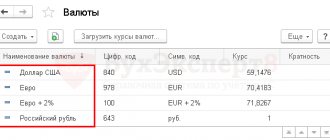What is primary documentation in accounting?
An example of a “primary document” in accounting is any document confirming transactions of a taxpayer. We are talking about transactions that are related to the economic activities of the organization and make economic sense.
All primary accounting documentation is described in Federal Law No. 402-FZ “On Accounting”. Documents must be collected and executed in accordance with this law in order to confirm expenses and prove to the Federal Tax Service the correctness of the calculation of the tax base.
The primary document must be drawn up at the time of the business transaction, since the document confirms its completion. Typically this is done by the supplier. The list of primary accounting documentation accompanying the transaction depends on the type of transaction and may differ. You need to be especially careful about the documents for transactions in which you are the buyer, since these are your expenses and you are more interested in the correct execution of documents than the supplier. The tax office may not credit the “primary” with errors.
Accounting registers for primary
Each primary document received by the accounting department must be registered. Therefore, there are special accounting registers. These are special counting tables made in a specific form. They are necessary to collect information about business transactions on accounts and not get confused in a bunch of certificates, invoices, and so on.
Accounting registers are different. As a rule, they are divided into the following categories:
- By appointment. This includes chronological (documents are recorded as they appear), systematic (the primary document is recorded taking into account its grouping characteristics). The combination of these two types is called synchronistic registers - ideally this is what accounting should do.
- By summarizing the data. Integrated (from particular to general) and differentiated (from general to particular) registers fall into this category.
- By appearance. Everything is very simple - they are divided according to the physical form of the register. It can be in the form of a card, book, electronic media, and so on.
Proper maintenance of accounting registers will significantly simplify the task and protect against many problems.
Storage of primary documents
The primary product must be stored for at least 5 years. During this period, the Federal Tax Service may request documents from you or your counterparties at any day in order to conduct an inspection. Documents will also be needed in case of legal disputes.
Previously, storing documents required racks, folders and a lot of paper. Now, to free up space in the office and save time and money, transfer the primary archive to electronic form. Accounting services help organize documents and store scans of them in an electronic archive - this makes it easier to search for documents. In the service list, it is easier to track the shortage of primary goods, closure, payment and transaction documents. Electronic documents are certified with an electronic signature.
If a company does not have a primary document whose mandatory storage period has not yet expired, it will receive a fine of 10 to 30 thousand rubles. Another problem with loss of documents is the inability to take into account expenses to calculate the tax base. In this case, the tax office will charge additional tax, and the company will have to pay extra.
Where to find samples
The process of developing and approving forms is carried out by representatives of the State Statistics Committee. Therefore, you can find the necessary samples on the website of this institution. There are numerous acts, invoices, journals, statements, books, orders and other papers.
Each documentation is approved by a separate Resolution, so company specialists have to study all regulations.
Attention! BSO are primary documents that have special requirements, so the list of required details is much higher than that of a standard primary document, for example, they indicate the Taxpayer Identification Number (TIN) and seal.
Primary documents are divided by business stage
All transactions of the company can be divided into three stages:
The first stage is an agreement on the terms of the transaction . The result will be an agreement and an invoice for payment.
The second stage is payment for the transaction . Primary documents confirming payment:
- Cash payments - cash receipt, receipt for cash receipt order, strict reporting form. Organizations rarely pay each other in cash, since the amount of payments through the cash register is limited to 100 thousand rubles. Employees usually receive advances or accountable money in cash.
- Electronic payments, including acquiring, payment systems or transfers from a current account - bank account statement.
The third stage is receiving products . Confirmation is required that the buyer has received the product or service, and the seller has received payment. Without supporting documents, the tax office will not allow you to include the funds spent in expenses. Receipt is confirmed:
- waybill;
- sales receipt;
- act of work performed or services rendered.
Common Mistakes
Popular mistakes that company employees make include:
- lack of required details;
incorrect information about the seller or buyer;- errors in the names of goods or their prices;
- vague or unclear wording;
- errors in calculations, for example, the price, tax or quantity of goods was incorrectly determined;
- inaccurate job titles of company employees who draw up and sign primary documents;
- the amount indicated in numbers differs from the value given in words.
Attention! Errors lead not only to the accrual of fines and penalties by tax inspectors, but also to problems for counterparties who are trying to obtain a VAT deduction.
If a company employee identifies violations, they can only be corrected using the proofreading method. To do this, incorrect information is crossed out with one line, and the current information is indicated above. The inscription “Corrected” is placed next to it, and the date the adjustments were made is also indicated. The responsible person puts his signature.
Attention! It is prohibited to correct errors in bank documentation, BSO or orders, so you have to fill out new forms.
Primary documentation in accounting list of documents 2020
Transactions vary significantly from company to company. Despite this, there is a list of primary documentation that is required in accounting:
- Agreement.
- An invoice for payment.
- Payment documents: cash receipts, strict reporting forms.
- Packing list.
- Certificate of work performed or services provided.
- Invoice.
This list of transaction documents is not exhaustive; it can expand depending on the types of transactions and accounting features in the organization.
Destruction
After the expiration of the established storage period, you can destroy the document, since it is no longer needed, and it is better to free up space.
Destruction must also be carried out according to established rules. You can't just take the paper, tear it up and throw it in the trash.
An expert commission should be appointed that:
- will check the documentation,
- will select the one for which the shelf life has expired and draw up a list of them,
- draw up an act of destruction;
- packs the papers in a special folder;
- will issue an invoice for recycling.
Further, unnecessary documentation is destroyed using our own means or the efforts of third-party companies.
Methods for destroying documents:
- burning;
- grinding;
- chemical disposal.
Formation of primary accounting documentation
The rules for maintaining primary documentation allow for its compilation using independently developed or unified forms (Article 9 No. 402-FZ). But remember that only a document containing all the necessary details has legal force:
- Title of the document.
- Date of creation.
- The name of the organization or the name of the entrepreneur of the compiler.
- Contents of a document or business transaction.
- Natural and monetary indicators.
- Data of responsible persons.
- Signatures of the parties.
The primary forms that the organization uses are fixed in the accounting policies. In the process of work, there may be a need to update or supplement forms - this is also recorded in the accounting policy.
Let's look at the primary documents in more detail.
When can only unified forms be used?
Organizations and entrepreneurs do not always have complete freedom in choosing the form of the primary document. Sometimes you need to use strictly unified forms.
Thus, when transporting goods by road, you can only use a consignment note approved by Decree of the Government of the Russian Federation No. 272 of April 15, 2011.
When carrying out non-cash payments, payment documents approved by banking legislation are used. In particular, by the Regulation of the Central Bank of the Russian Federation No. 383-P dated June 19, 2012.
Cash documents must be unified: receipt and expenditure orders, a book of accounting for funds accepted and issued by the cashier, a cash book, payment and settlement statements. This is a requirement of Bank of Russia Directive No. 3210-U dated March 11, 2014.
Agreement
When concluding a transaction, the parties enter into an agreement between themselves, which stipulates all the conditions and details of future business transactions: terms of shipment of goods, performance of work or provision of services, time for payment, payment method, etc.
Additionally, the contract records data on the subject of the transaction and the price. The rights and obligations of the parties also need to be spelled out to make it easier to resolve possible disputes in court.
It is optimal if each transaction is formalized in a separate agreement. But companies often enter into one general agreement with regular counterparties for a number of similar transactions at once. Draw up two copies of the agreement with seals and signatures of the parties on each.
A written form of agreement is not always necessary. For example, for a purchase and sale transaction, the document confirming the conclusion is a cash receipt or sales receipt.
Classification
There is one-time and cumulative primary documentation. The processing of information contained in such papers has a number of features.
One-time documentation is intended to confirm an event once. Accordingly, the procedure for processing it is significantly simplified. Cumulative documentation is used for a certain time. As a rule, it reflects an operation performed several times. In this case, when processing primary documentation, information from it is transferred to special registers.
An invoice for payment
An invoice is a document in which the seller sets the price for his services or goods.
The buyer agrees to the supplier's terms and conditions at the time of payment. The legislator does not establish the form of the invoice, so each company draws it up in its own way. The invoice specifies the terms of the transaction, terms, payment and delivery procedures, etc.
The signature of the director or chief accountant on this document is not required (Article 9 No. 402-FZ). But to avoid any questions from the tax authorities or counterparties, it is better not to neglect them. An invoice for payment does not provide an opportunity to present demands to the supplier - it only records the purchase price. The buyer retains the right to demand a refund in case of violation of the terms of the contract or illegal enrichment of the supplier.
Bill of lading or sales receipt
Sales receipts are issued in two cases: when selling goods by individuals or when selling to individuals.
Invoices, as a rule, are used by organizations to document the sale of goods and their further receipt by the buyer.
Like the contract, the invoice is drawn up in two copies. One remains with the supplier to confirm the transfer of goods, and the second is received by the buyer to confirm receipt.
The data in the delivery note and invoice must match.
The person who releases the goods puts his personal signature and the company seal on the delivery note. And the buyer also certifies the document with a signature and seal.
Required details
When compiling the primary report, some mandatory information must be included. Without them, the document is considered incorrectly executed, which entails holding the company liable. These details include:
- correct name;
- information about the company that generates the documentation;
- meters;
- signature and position of the person who compiled the primary document.
Attention! This information is checked by inspectors in the process of studying the company's activities.









